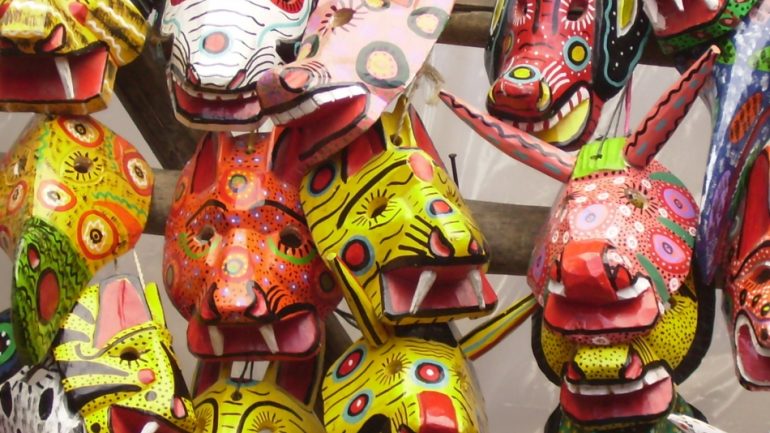The Ceremonial Mask

- Posted by Mundo Spanish School
- Posted in Articles
The masks are part of the Guatemalan tradition that has lasted since pre-Hispanic times. The masks are part of the lives of men, those who used them in Rome, Greece, Egypt and other countries was to fulfill the main function of “transforming the personality of who uses it, giving it the character of the mask” Masks in the pre-Hispanic world had an eminently religious and ritual function that later moved to dances as well. There are masks for traditional dances such as El Venado, La Conquista, El Torito, Moors and Christians, these last three date from the time of the colony.
The ancient Mayans put on a mask and dressed in a particular way. The priest placed that of the deity and in this way the contact between the world of the sacred and the world of the profane was established.
The shape of the masks usually comes from nature: they are mainly zoomorphic or anthropomorphic. For the size, they take measures humans to do the real thing, since those who use it should feel as comfortable as possible.
MANUFACTURE: The common mask is carved from a single piece of wood to which are added, as the case may be, eyes, tongue, ears, which are carved separately, painted, and decorated. A piece of wood is cut; then, completely by hand, the area to be hollowed out as well as the thickness mark is traced backwards. With a machete, small chisel ax, although nowadays other tools are used in carpentry. The features are marked, the nose is carved, the mouth is cut and openings are made by which the dancer can see. Once the carving is finished, dry the mask to the sun so that it does not shrink or crack after a short time of use. Once the mask is carved, it can follow the base painting process, that is, cover the surface with a base or base to receive the final finish (in some cases the plaster is used), especially if the wood has pores. The next step is the polishing and then the application of the paint, in generally very vivid colors that help to detail the facial features such as the folds of the skin and the expression of the eyes.
LAS MÁSCARAS CEREMONIALES
Las máscaras son parte de la tradición guatemalteca que ha perdurado desde la época prehispánica. Las máscaras son parte de la vida de los hombres y quienes las utilizaban tanto en Roma, Grecia, Egipto como en otros países era cumplir con función principal de “transformar la personalidad de quién la usa, dándole la del personaje que representa la máscara” Las máscaras en el mundo prehispánico tenían una función eminentemente religiosa y ritual que posteriormente se traslada también a las danzas. Existen máscaras para danzas tradicionales como El Venado, La Conquista, El Torito, Moros y Cristianos, estás tres últimas datan del tiempo de la colonia.
Los antiguos mayas se ponían una máscara y se ataviaban de una forma particular. El sacerdote se colocaba la de la deidad y de esa forma se establecía el contacto entre el mundo de lo sagrado y el mundo de lo profano.
La forma de las máscaras procede normalmente de la naturaleza: principalmente son zoomorfas o antropomorfas. Para el tamaño, toma muy en cuenta las medidas humanas, puesto que, quien la usa debe sentirse lo más cómodo posible.
FABRICACIÓN: La máscara común se talla de una sola pieza de madera a la que se le añaden, según el caso, ojos, lengua, orejas, que se tallan por separado y se pinta y se decora. Se corta un trozo de madera; luego, totalmente a mano se traza por atrás la zona a ahuecar así como la marca del grosor. Con un machete, hacha pequeña formón, aunque en la actualidad se usa otras herramientas en la carpintería. se marcan las facciones, se talla la nariz, la boca y se hacen as aberturas por las que el danzante podrá ver. Terminado el tallado pone a secar la máscara al sol para que no se encoja o se agriete a poco tiempo de uso. Una vez tallada la careta, puede seguir el proceso de pintado base, es decir, cubrir la superficie con una base o fondo para recibir el acabado final (en algunos casos se usa el yeso), especialmente si la madera tiene poro. El siguiente paso es el pulido y después la aplicación de la pintura, en colores generalmente muy vivos que ayudan a detallar los rasgos faciales como los pliegues de la piel y la expresión de los ojos.
